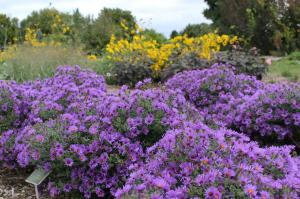Entertainment - Media News Watch originally published at Entertainment - Media News Watch
Ornamental Trial Program Evaluating USDA Plant Hardiness Zone 5, 6 & 7 Plants
Amid Prolonged Drought, Warmer Winters, Hotter Growing Seasons in Zones 5a&b
— David McKinney
MADRID, IOWA, UNITED STATES, December 29, 2023 /EINPresswire.com/ — Iowa’s gardens end 2023 having suffered 188 straight weeks of drought, according to December data from the U.S. Drought Monitor. Even if they provided the most ideal plant care, most Iowa gardeners enter 2024 with at least some dead plants, shrubs, or trees to replace.
The updated USDA Plant Hardiness Zone Map https://planthardiness.ars.usda.gov/, released Nov. 15 and last updated in 2012, reported major warming patterns. Based on 30-year averages of the lowest winter temperatures, the map divides the U.S. by 10-degree and 5-degree zones. About half of the country shifted to the next warmer half-zone (5-degree avg. winter temp. increase) in the 2023 map revision.
While Iowa retained its 5a and 5b Plant Hardiness Zones, low temperatures are not the only significant factor that kills plants in Iowa, according to David McKinney, curator of the Iowa Arboretum & Gardens https://iowaarboretum.org, where he oversees the care of over 6,000 plant accessions amid a collection of trees, shrubs, and plants native to or viable within Iowa. “Both the horticultural industry and consumers need broader performance information on plants to make more resilient choices for our gardens and landscapes,” says McKinney. “This trial program focuses on all environmental factors, including humidity, precipitation, light intensity, heat, cloud cover, soil type, soil pH, and water hardness.”
Due to a lack of regionally specific research, demonstration, and outreach surrounding newly introduced ornamental plants in Central Iowa, the Iowa Arboretum & Gardens established a trial program for herbaceous perennials and shrubs. Launched with the plantings of the first varieties in 2023, the trial garden in 2024 will feature submissions from 26 different plant developers and propagators.
“The need is real for more localized information on plants’ specific performance, especially under adverse or prolonged unfavorable growing conditions,” McKinney says. “While Iowa is currently in Zone 5a/5b, plant developers know that the climate is becoming less predictable and that plants from other regions and countries may not only survive but thrive here.
While 2023 trial plants received supplemental water every week that rainfall did not exceed one-half inch to become established, they will only receive supplemental water in 2024 if they exhibit life-threatening stress (wilting, scalding, flagging).
Trial garden plants are evaluated by Arboretum staff and select industry and consumer partners for their year-round vigor, uniformity, disease/pest resistance, floriferousness, potential to become invasive, resilience, seasonal interest, and survivability.
Each August, the Arboretum will hold summer evaluation celebrations – one for the horticultural community and one for the public – to evaluate and provide feedback on ornamental garden trial plants. Annual reports on their evaluation will be available on the Arboretum’s website https://iowaarboretum.org/collections-home-page/trialprogram/. Trial gardens are open to the public as part of admission to Iowa Arboretum & Gardens grounds during its April through October growing season. Arboretum admission is $10 for adults and $5 for children.
Beyond the trial garden, McKinney also has developed a long-range plan to help curate the Arboretum’s wider collection and its grounds to account for climate change. This includes refining planting programs to ensure no one plant genus comprises more than 5 percent of the collection. He is experimentally planting unique and generally unknown conifers, which will possibly perform well in Iowa’s warmer, drier climate, while increasing the use of native trees, such as Sweet Gum and Black Gum. McKinney also is selecting more drought-resistant tree varieties, such as Korean Maple. From southern gardens, McKinney says forward-looking Iowa gardeners may consider planting Spring Grove Flowering Dogwood, Dwarf Sumac, Hercules’ Club, Hardy Crepe Myrtles, Red Yucca, and Peruvian Lily.
Iowa gardeners interested in learning more about refining their landscapes to cope with climate change soon can register on the Arboretum’s website for its annual Spring Fever Symposium, April 6, titled “Great Gardening on the Great Plains.” The day-long event at the Arboretum’s Hughes Education Center features speakers from Iowa, Wisconsin, and Colorado offering ideas on how Iowa gardens can become more diverse and resilient as states across the Great Plains share a similar climate going into the next century.
The Iowa Arboretum & Gardens is a community-supported public garden inspiring curiosity, discovery, and appreciation of the natural landscape. Established in 1968 as a non-profit organization by the Iowa Horticultural Society in Boone County near Madrid, the Iowa Arboretum became a stand-alone organization in 1979. The Arboretum’s vision is to be a leading botanical, educational, and recreational destination fostering the value and enjoyment of nature. It features 160 acres displaying a unique collection of Iowa trees, landscape plants, and native ecosystems.
Mark H Schneider
Iowa Arboretum & Gardens
+1 515-795-3216
[email protected]
Visit us on social media:
Facebook
LinkedIn
Instagram
![]()
Originally published at https://www.einpresswire.com/article/678070387/trial-by-fire-for-perennials-shrubs-and-trees-at-iowa-arboretum-gardens
Entertainment - Media News Watch originally published at Entertainment - Media News Watch





